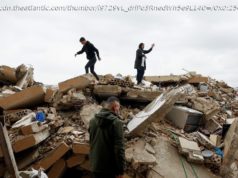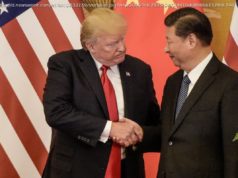All eyes are on the next milestone for the Korean Peninsula: the summit between U. S. President Donald Trump and North Korean leader Kim Jong Un.
SEOUL, April 28 (UPI) — After the two Koreas reached a landmark agreement Friday, declaring their shared commitment to denuclearization and peace on the Peninsula, all eyes are on the next milestone: the summit between U. S. President Donald Trump and North Korean leader Kim Jong Un.
One of the biggest questions is whether Trump and Kim will see eye-to-eye on the concept of denuclearization.
Seoul and Washington have made it clear that they want a complete, verifiable and irreversible denuclearization, known as CVID, however, the North has not openly conveyed its willingness to undergo a full-fledged, transparent dismantlement of its nukes.
“Denuclearization is not a final event,” said Kim Joon-hyung, Professor of Handong Global University, said Thursday, during a panel debate at the inter-Korean summit press center.
“CVID is the final goal and denuclearization is just a process. It’s moving forward, like closing down Punggyeri.”
The regime, has so far, announced it will stop nuclear and intercontinental ballistic missile tests, as well as close down the North’s main test facility of Punggyeri, where all six of its nuclear tests have been launched.
However, a point of concern experts have raised is that the moratorium of nuclear and missile testing or development still means the North’s assets are fully operational if the regime decides to change its mind.
“In the minds of North Koreans, they may have different interpretation [of denuclearization]. Without giving out its delivery system for mid-range or short-range missiles, it will still be armed and be, to a certain extent, comfortable against threats from American allies,” said Lee Geun, Professor of Seoul National University.
Even if the North comes to the negotiation table with full understanding that Washington will require CVID, the challenge remains in working out the process and its timing.
“It is not easy to go through a freeze declaration, challenging inspections, and verifiable dismantling. From technical terms, it will take more than two and a half years. There is a dilemma with regards to CVID in North Korea,” said Moon Chung-in, the South Korean president’s special advisor on foreign affairs and security.
“We say it has to be fast, and certainly from American perspective, we want it as quickly as possible but we have to be realistic. If you’re Kim Jong Un, or his elite, or North Koreans, insofar as they feel protected by that, as part of that state, there is a danger in going too quickly for them,” said John Delury, a North Korea expert at Yonsei University.
Another possible sticking point between the U. S. and North Korean leaders is what kind of reward or incentive Trump can offer the North in return for CVID.
Before the historic inter-Korean summit on Friday, the South Korean president said the North hasn’t made any “unacceptable” demands from the United States in return for denuclearization.
“North has only spoken of the end of hostile policies against it and the security guarantee of the regime,” he said on Apr. 19.
However, some experts have warned that the terms of the Panmunjeom Agreement suggest otherwise.
Pyongyang has long called for the removal of the U. S. nuclear umbrella and military presence in the South and scrapping of South Korea-U. S. joint military exercises, claiming they pose a threat to the regime.
In the document, Seoul and Pyongyang pledge to work towards the denuclearization of the entire Korean Peninsula, not specifically North Korea.
As South Korea does not have nuclear weapons of its own, this may pertain to U. S. strategic assets that have been deployed to deter threats from North Korea, according to Kim Tae-woo, former president of the Korea Institute for National Unification.
The expert cited that Seoul and Pyongyang also promised to pursue a peace treaty within the year, and end the 65 years of cease-fire following the 1950-53 Korean War.
Trump said earlier this month that the two Koreas “have his blessing to discuss the end of war.”
However, Kim Tae-woo warned that the U. S. president must think twice before supporting a permanent peace accord.
“Declaring an end to war, simply means that the Korean War has come to end. However, a peace treaty is no different from a non-aggression pact. This would take away the grounds for the South Korea-U. S. alliance and the presence of the United Nations command,” Kim said.
“Creating the legal grounds to eradicate such military presence” would leave the South vulnerable to the North’s provocations should the regime decide to change its mind, according to Kim.
“South Korea isn’t the one that makes provocations. It is the North that maintains a certain level of external tension and provocations to keep the regime’s grip on internal order. This has not changed,” he said.
Even if the North agrees on a complete and verifiable dismantlement of its nukes, Kim says it should only go as far as the lifting of sanctions, the normalization of state relations, diplomatic relations, and economic cooperation.
One of the North Korean leader’s signature Byeongjin Policy goals is to achieve economic advancement for his people.
“Kim Jong Un has been convinced from childhood to make his people rich. Now he has a weapon, he can get a lot of things in return. If price is right, he has sincerity in that sense. If price is not right, he can go back,” Kim Jun-young said.
It will take a long time for the two Koreas to see a “system of co-existence” stabilize with trust that the North no longer poses a threat, according to Kim Tae-woo.
“Before it resolves its dictatorial system, the power structure of the regime as well as its flagrant violations of human rights, we cannot be assured they have changed. Once they show such change, then it wouldn’t matter whether there is or isn’t a peace treaty between the Koreas,” the expert said.
Analysts say it is ultimately down to the question of the North’s sincerity to completely and irreversibly pull the plug on its nukes, and keep its word on promises.
Home
United States
USA — mix Experts warn of possible pitfalls of North Korean denuclearization talks






